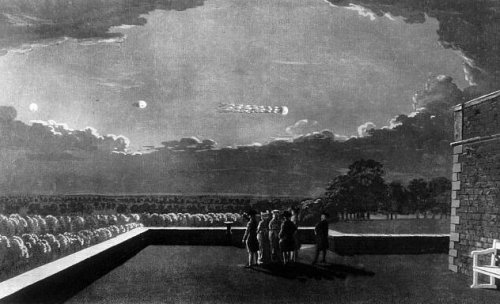UFOs and aliens in the works of historians of the ancient world
There are many historical documents describing the appearance of UFOs during classical antiquity (IV century BC — II century AD). Of course, some of these messages can be explained by natural or cosmic phenomena, but not all. there are confirmed reports describing the appearance of UFOs and it can be concluded that the UFO phenomenon has not changed much in two millennia.
Flying weapons
Most reports about flying weapons come from Livy (the greatest Roman writer and historian Titus Livy (59 BC - 17 AD) and from the Annals of Maxims published by the Roman historian Maximus (Valerius Maximus, Marcus, the first half of the I century AD, a Roman historian who worked during the reign of Tiberius).

The area of UFO sightings is limited to central Italy. The military terminology reflects the most advanced technology unknown at the time, a trend also found in modern UFO reports where the witness is looking for a familiar technical term to describe an unexplained phenomenon. The fact that many of the reports were made during wartime may explain the military terminology.
UFO in Rome in the winter of 218 BC
the sight of ships (navium) sparkling in the sky
Livy. 21.62.4:
in Arpi, round shields (parmas) were visible in the sky
Livy. 22.1.9; Orosius 4.15:
Parmas were a small round shield, partially or completely made of iron, bronze or other metal. Therefore, it is logical that observers applied this term to the sparkling, reflective, shiny disc-shaped UFOs that they saw in the sky.
In 212 BC.
a huge stone (saksum) was seen flying in Riata
Livy. 25.7.8:
Apparently, it is implied that the flying object was stone-gray in color. Sporadic reports of such objects continue to appear after that in the lists of Roman historians.
The direct sources are again Livy, Pliny, Plutarch, Obsequens and Orosius:/p>
In 173 BC.
in Lanuvium, we saw the spectacle of a huge fleet in the sky
Livy. 42.2.4:
In 154 BC.
Comps has a weapon (arma) flying in the sky
Obsequens 17:
This term refers to defensive weapons, especially shields.
In 104 BC.
the residents of Ameria and Tuder watched as the weapons in the sky rushed together from the east and west, and those from the west crashed.
Quote:
Pliny uses the term arma; Plutarch calls the weapons “flaming spears and oblong shields.
In 100 BC.
in Rome,"a round shield (clypeus), burning and emitting sparks, ran across the sky from west to east at sunset.
Pliny:
The Clipeus was a round shield, similar to the Parma, but larger.
in Rome, the spectacle of defensive and offensive weapons (types of telorum armorum) was noticed, which rumbled up from the ground into the sky.
Quote:
The most famous “heavenly army” appeared in the spring of '65 over Judea. The historian Josephus reports:
A wonderful phenomenon happened in the month of Artemisia. Before sunset, chariots in the air and armed phalanxes were seen in all parts of the country, rushing through clouds and exciting cities
Quote:
Josephus probably observed this phenomenon himself and investigated it, as he turns to eyewitness accounts to confirm what he saw. This phenomenon really resembles the “air battles” of modern UFOs.
Quote:
Fireballs
The first group of reports of fireballs falls on the Second Punic War.
Livy reports that in 217 BC
two moons rose in Kapen that afternoon. Then one moon fell and there was a heavy downpour
Livy and Orosius:
Three moons appeared simultaneously in 223 BC and in 122 BC. This is reported in the works of Livy, Orosius, Apuleius, and Zonaras.
Seneca gives two examples of the appearance of UFOs over the eastern Mediterranean. In 168 BC, when L. Aemilius Paul waged war against the Macedonian king Perseus,
The ball spewing fire was the size of the moon.
Quote:
A more complex object appeared sometime between 151 and 146 BC.
a fire broke out in the sky, not inferior to the sun. At first it was a fiery red disk, emitting a light so bright that it scattered the night. Then, little by little, its size decreased and its brightness faded; finally the light completely went out
Pliny:
Over the city of Rome
around sunrise, a fireball burst out of the northern region with
Orosius:
a loud noise in the sky.
In the same year, a much stranger object was spotted near Spoleti:
The Romans saw a golden-colored ball, which then became like a spear and it fell down from the sky to the ground; after it became larger, it was seen that it was rising up again, and the earth was rising from below behind it
Orosius:
Pliny also reports an incident that at first glance
is similar to the previous one, but occurred at night:
It was seen how the spark falls from the star and grows as it approaches the earth; after it became as big as the moon, the light scattered around, as on a cloudy day; then, retreating to the sky, the object turned into a torch. It is recorded that this happened only once: Proconsul Silanus and his retinue saw it in the consulate of Gnaeus Octavius and Gaius Scribonius
Quote:
M. Junius Silanus was governor of the province of Asia in 76 BC, and the incident probably occurred there. Silanus' testimony receives indirect support from Lidus for several later cases of the same phenomenon, although without reference to the torch.
Only four centuries later, the following report appears in this category:
In Antioch, in the afternoon, a star was visible in the eastern part of the sky, emitting abundant smoke, as from a furnace, from the third to the fifth hour
Quote:
This happened around 334, and was recorded by the Byzantine chronicler Theophanes.
A fiery column appeared near Athens in 404 BC on a moonless, stormy night,
writes Julius:
In 74 BC, when the Roman army under the command of L. Licinius Lucullus was about to engage in battle with the troops of the Pontic king Mithridates VI. According to Plutarch:
But soon... without a visible change in the weather, but suddenly the sky was torn apart, and a huge, flame-like body was seen falling between
Quote:
two armies. In shape, it most resembled a wine jug (pitcher), and in color resembled molten silver. Both sides were amazed by this sight and dispersed. This miracle happened in Phrygia, in a place called Otrii
The presence of thousands of witnesses, including Lucullus and Mithridates, confirms the fact of this incident. The term pitos was usually applied by ancient meteorologists to any large smoky celestial fire in the shape of a barrel, according to Posidonius.
According to modern experience, such an episode would easily fall under the category of a classic close encounter with a UFO.
The fourth case is known from the biography of St. Anthony, written by Athanasius, Bishop of Alexandria, after a personal conversation with a witness several years later. The date was 285, in Fayoum or near it in the Egyptian desert.
a large silver disk appeared on the desert sands, which suddenly disappeared like smoke
Quote:
Close contacts of the second kind
There are no records in ancient literature that an object similar to a UFO pressed an imprint into the ground or left material remnants. On the other hand, rains of strange material have been reported from time to time, and since then similar reports have appeared in modern UFO research.
Modern reports say that the whitish thinnest substance, called “angel hair”, in rare cases fell out of UFOs, and then quickly disappeared upon contact with the earth. In other reports, vitreous fibers are left by UFOs after takeoff from earth, or a chalky substance remains.
An ancient sample of “angel hair” may have been picked up in Rome in 1967 by historian Cassius Dio, who writes:
A fine rain, like silver, descended from a clear sky on the Forum
Quote:
Aug. True, I did not see him when he fell, but I noticed him after he fell, and with his help I covered several bronze coins with silver; they kept the same appearance for three days, but by the fourth day all
the substance rubbed into them disappeared.
Other cases in which a solid whitish substance has been involved include two “chalk rains”, one at Keils in 214 BC and another at Rome in 98 BC.
Close contacts of the third kind
Cases when creatures associated with UFOs have been observed, usually described as human or humanoid.
According to Livy, in 214 BC.
in Hadria, an altar was visible in the sky; around it were figures of people dressed in shining white.
Quote:
The nature of the altar (ara) is not specified. But four years earlier:
in the Amiternum district, in many places, figures of people dressed in shining white were visible in the sky; they did not approach anyone.
Quote:
The last encounter is again taken from early Christian hagiographic
literature and took place near the Via Campana between Rome and
Capua in 150g.
On a sunny day, a "beast", similar to a piece of a jug about 30 meters in size, multicolored from above and emitting fiery rays, landed in a cloud of dust, accompanied by a "girl" dressed in white,
from the writings of She-Mas, the brother of Pope Pius.:
If we summarize all the mentions of UFOs in antiquity, then:
- shape—discoid or spheroidal;
- color—silver, golden or red;
- texture—metallic or, sometimes, luminous or cloudy;
- size—from a meter to 30 meters or more;
- sound—usually not reported;
- type of movement—soaring, erratic or smooth flight, with fast disappearance.
In at least one case, the presence of "tenants" dressed in shiny white clothing is reported. Encounters range from distant glimpses to possible actual contact; the preferred place and time of observation are rural areas during the day.
About author:
Serg Toporkov Ufologist, Ph.D., blogger, I go on my own expeditions for UFOs. I use scientific methods to investigate the UAP phenomenon. Write to me |
Related tags:
UFO ufo sightings past ancient aliens flying saucers historians history ancient worldRandom UFO or conspiracy article
Men in Black in the Soviet Union
 Despite the fact that the KGB of the USSR has always officially denied the presence in these departments of special forces engaged in the study of UFOs, every now and then there are witnesses claiming that they personally saw "people in black" and even talked to them.
Despite the fact that the KGB of the USSR has always officially denied the presence in these departments of special forces engaged in the study of UFOs, every now and then there are witnesses claiming that they personally saw "people in black" and even talked to them.
